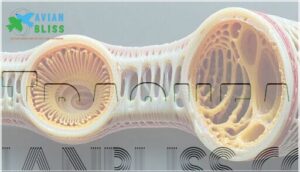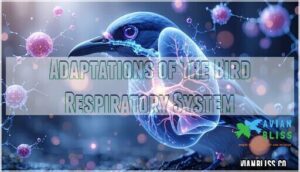This site is supported by our readers. We may earn a commission, at no cost to you, if you purchase through links.
 When you wonder how does a bird get oxygen, you’re looking at nature’s most efficient breathing system.
When you wonder how does a bird get oxygen, you’re looking at nature’s most efficient breathing system.
They’ve got nine specialized air sacs that work like bellows, pushing fresh air through rigid lungs filled with tiny air capillaries.
This setup extracts oxygen so effectively that birds can fly at altitudes that would leave you gasping for breath.
The system works continuously during flight, with wing movements actually helping pump air through their bodies.
This respiratory powerhouse also enables their incredible songs and marathon migrations across continents.
Table Of Contents
- Key Takeaways
- The Respiratory Process of a Bird
- The Anatomy of a Bird’s Respiratory System
- The Role of Air Sacs in Bird Respiration
- Comparing Bird and Mammal Respiration
- The Benefits of Bird Respiration
- Adaptations of The Bird Respiratory System
- How Birds Breathe While Flying
- Breathing Patterns of Birds
- Do Birds Breathe Through Their Beaks?
- How Birds Obtain Oxygen Underwater?
- Frequently Asked Questions (FAQs)
- How do birds get their oxygen?
- Do birds get out of breath from flying?
- How do vets give birds oxygen?
- Do birds breathe with lungs or gills?
- Can birds suffocate from blocked nostrils?
- Do baby birds breathe differently than adults?
- How do birds breathe in polluted air?
- Can birds get respiratory infections like humans?
- Do different bird species have varying oxygen needs?
- Conclusion
Key Takeaways
- You’ll find that birds use nine specialized air sacs that work like bellows, continuously pushing fresh air through their rigid lungs in one direction, making their breathing system 25% more efficient than your mammalian lungs.
- You’re witnessing nature’s most advanced oxygen delivery system when you watch birds fly at high altitudes – their unidirectional airflow through tiny air capillaries called parabronchi allows them to extract maximum oxygen even where you’d struggle to breathe.
- You’ll discover that birds don’t have a diaphragm like you do – instead, their interconnected air sacs create continuous airflow that never stops, ensuring fresh oxygen reaches their muscles during demanding flight maneuvers.
- You can’t replicate what birds achieve underwater – diving species like penguins store extra oxygen in their muscles and slow their metabolism to hold their breath for extended periods, since they can’t extract oxygen from water like fish do, using their specialized air sacs and unidirectional airflow to optimize their breathing.
The Respiratory Process of a Bird
When you watch a bird soar through the sky, you’re witnessing one of nature’s most efficient oxygen delivery systems at work.
Soaring birds showcase evolution’s masterpiece: a respiratory system that turns every breath into pure flying power.
Birds use a unique two-cycle breathing process that moves air through specialized air sacs and lungs, ensuring they receive a continuous supply of fresh oxygen to power their high-energy flight demands, which is a remarkable example of efficient oxygen delivery.
Breathing Cycle
A bird’s breathing cycle operates through a unique two-cycle process that creates continuous airflow direction through specialized air sacs.
During inhalation mechanics, fresh air fills posterior air sacs, then moves into avian lungs for gas exchange.
Exhalation mechanics push air into anterior air sacs, then out through the trachea.
This bird respiration system guarantees constant oxygen supply, making bird breathing remarkably efficient.
Gas Exchange
Oxygen flows into your bird’s bloodstream through an intricate process that puts mammalian lungs to shame.
The parabronchi function as tiny tubes where crosscurrent exchange maximizes efficiency.
Here’s how gas exchange works:
- Hemoglobin affinity captures oxygen molecules instantly
- Carbon dioxide gets swept away simultaneously
- Altitude adaptation allows breathing at extreme heights
- Metabolic demands are met through continuous airflow
This avian lung design guarantees bird oxygen intake never falters during flight’s demanding energy requirements.
Airflow and Circulation
Fresh air moves through your feathered friend’s body like a well-oiled machine.
Your bird’s respiratory system works like nature’s most sophisticated air conditioning unit, never missing a beat.
Unidirectional airflow guarantees oxygen never stops flowing, while air sac volume adjusts to meet metabolic demands.
This countercurrent exchange system maximizes blood oxygenation, making avian lungs incredibly efficient.
Air flow patterns create respiratory efficiency that puts mammals to shame.
| Airflow Component | Function |
|---|---|
| Air sac bellows | Push fresh air through bird air sacs continuously |
| Unidirectional system | Prevents stale air from mixing with fresh oxygen |
| Blood vessels | Enable countercurrent exchange for maximum absorption |
| Parabronchi tubes | Create efficient pathways for air flow circulation |
| Muscle contractions | Generate pressure changes for ideal bird respiration |
The Anatomy of a Bird’s Respiratory System
You’ll discover that a bird’s respiratory system includes three main components: compact lungs, multiple air sacs, and a flexible trachea that work together to create continuous airflow.
These specialized structures allow birds to extract oxygen far more efficiently than mammals, with air sacs acting as bellows to keep fresh air moving through the lungs in one direction.
Lungs
Unlike mammalian lungs that expand and contract, avian lungs maintain lung rigidity while air flows continuously through specialized tubes called parabronchi.
This unique bird lung anatomy creates a countercurrent exchange system where blood flows opposite to airflow direction, maximizing oxygen extraction.
Your bird’s respiratory system achieves remarkable efficiency through this design, allowing avian hemoglobin to capture more oxygen per breath.
The parabronchi function guarantees unidirectional airflow, making bird respiration far more effective than traditional breathing methods.
Air Sacs
Think of air sacs as your body’s built-in oxygen delivery network.
These remarkable structures, numbering nine in most birds, act like biological bellows scattered throughout your chest and abdomen.
Air sac location varies strategically, with some positioned near major organs for maximum metabolic oxygen supply.
Through countercurrent exchange mechanisms, they maintain continuous airflow through your lungs.
This efficient bird respiratory system guarantees fresh oxygen reaches every cell, supporting everything from high-altitude flight to aquatic bird buoyancy control.
Trachea
When you examine a bird’s respiratory system, the trachea stands out as a remarkable windpipe that’s perfectly engineered for flight.
This flexible tube connects the throat to the lungs, featuring specialized cartilage rings that prevent collapse during rapid movements.
The avian trachea offers three key advantages:
- Tracheal flexibility allows birds to twist their necks without blocking airflow
- Variable trachea diameter accommodates different breathing demands during flight
- Protective tracheal mucus filters particles while maintaining smooth air passage
These tracheal adaptations showcase millions of years of trachea evolution, creating the ultimate bird breathing mechanism.
The Role of Air Sacs in Bird Respiration
You’ll discover that air sacs function as specialized bellows throughout a bird’s body, creating continuous airflow that keeps fresh oxygen moving through the lungs even during exhalation.
These nine interconnected chambers, including four paired sacs and one central sac, work together to maintain the unidirectional breathing system that makes birds the most efficient breathers in the animal kingdom, utilizing their unique physiology to achieve this efficient breathing process.
Function of Air Sacs
Avian air sacs work like biological bellows, pumping fresh oxygen through your bird’s lungs with remarkable efficiency.
This air sac network maintains constant avian lung inflation, ensuring metabolic oxygen supply never falters during flight or rest.
| Air Sac Function | Flight Benefit | Diving Benefit | Energy Cost |
|---|---|---|---|
| Bellows Action | Sustained oxygen at altitude | Extended underwater time | Minimal effort required |
| Volume Control | Air sac volume adjusts for demand | Aquatic bird buoyancy regulation | Efficient gas exchange |
| Heat Exchange | Air sac countercurrent prevents loss | Temperature regulation | Reduced energy waste |
| Continuous Flow | Unidirectional airflow maintained | Oxygen storage capacity | Maximum efficiency achieved |
Distribution of Air Sacs in The Body
You’ll find avian air sacs strategically positioned throughout a bird’s body like tiny balloons tucked into every available space.
Air sac distribution creates an interconnected network that maximizes skeletal integration and muscle interaction while maintaining ideal body cavity pressure.
- Cranial air sacs – Located in head and neck regions
- Thoracic air sacs – Positioned within chest cavity
- Abdominal air sacs – Situated in lower body
- Interclavicular sac – Single unpaired sac near wishbone
- Cervical air sacs – Extended into neck vertebrae
Comparing Bird and Mammal Respiration
You’ll discover that bird and mammal respiratory systems work in completely different ways, with birds using a one-way airflow system while mammals breathe air in and out through the same pathway.
This fundamental difference makes bird respiration about 25% more efficient at extracting oxygen from the air, which explains how they can soar at high altitudes where mammals would struggle to breathe, due to the increased efficiency of their respiratory system being a key factor in their ability to thrive in such environments, making their respiration system highly efficient at extracting oxygen.
Differences in Lung Structure
While your mammalian lungs expand like balloons, bird lungs maintain rigid structures with densely packed parabronchi that create unidirectional airflow dynamics.
These tube-like passages maximize capillary density for superior gas exchange.
Despite their compact avian lung size, this parabronchi structure delivers oxygen more efficiently than your flexible lung design, supporting the incredible energy demands of avian anatomy and physiology.
Efficiency of Oxygen Transfer
Birds consistently outperform mammals in oxygen transfer through their sophisticated respiratory system.
Your typical bird extracts 25% more oxygen per breath than you do, thanks to specialized adaptations that maximize efficiency.
Here’s why bird oxygen absorption dominates:
- Countercurrent Exchange – Blood flows opposite to air direction in parabronchi structure, maximizing gas exchange
- Hemoglobin Affinity – Bird blood proteins grab oxygen more effectively than mammalian versions
- Blood Pressure – Higher circulation rates deliver oxygen faster to tissues
- Metabolic Rate – Enhanced processing supports demanding flight requirements
- Avian Respiration – Unidirectional airflow guarantees continuous fresh oxygen supply
This bird respiratory efficiency enables remarkable feats like high-altitude flight.
The Benefits of Bird Respiration
You’ll discover that birds possess the most efficient respiratory system in the animal kingdom, extracting 25% more oxygen from air than mammals can achieve.
Their specialized breathing apparatus enables remarkable abilities like soaring at extreme altitudes, sustaining continuous flight for thousands of miles, and producing complex songs that require precise airflow control.
Their respiratory system allows for sustaining continuous flight for thousands of miles.
Flight at High Altitudes
Picture yourself soaring above Mount Everest – that’s where a bird’s respiratory prowess truly shines.
Their efficient respiration system conquers thin air that would leave you gasping. Bar-headed geese routinely fly over the Himalayas at 29,000 feet, where oxygen levels drop to just one-third of sea level.
Birds achieve this feat through unidirectional airflow in their lungs.
- Altitude adaptations include enlarged lungs and enhanced blood oxygen capacity
- Hypoxia tolerance allows sustained flight in oxygen-poor environments
- Oxygen extraction efficiency increases dramatically at extreme elevations
- Avian adaptations enable birds to thrive where mammals struggle to survive
Efficient Oxygen Absorption
Twenty-five percent more oxygen enters your bird’s bloodstream compared to mammals, thanks to specialized parabronchi function and countercurrent exchange mechanisms.
Enhanced hemoglobin affinity grabs oxygen molecules efficiently, while the avian respiration system’s continuous airflow maximizes gas exchange.
This superior oxygen supply meets intense metabolic demands, supporting everything from basic survival to complex altitude adaptation in the bird respiratory system.
Singing and Vocal Abilities
Beyond efficient oxygen absorption, your feathered friends transform breathing into beautiful music.
The avian respiratory system powers remarkable vocalizations through the syrinx, their specialized voice box located where the trachea splits.
- Syrinx Function: Controls airflow to create diverse sounds and melodies
- Vocal Mimicry: Enables parrots to replicate human speech patterns perfectly
- Song Complexity: Produces intricate musical phrases using precise air pressure
- Learned Songs: Young birds master vocalizations by controlling respiratory muscles
- Avian Dialects: Regional variations develop through unique breathing techniques
Air sacs and parabronchi work together, making every song possible.
Adaptations of The Bird Respiratory System
You’ll discover that birds have evolved remarkable respiratory adaptations that set them apart from mammals, including the absence of a diaphragm and specialized air capillaries in their lungs.
These unique features, combined with their resistance to airborne toxins, allow birds to extract oxygen more efficiently and survive in challenging environments where other animals can’t thrive, due to their ability to extract oxygen more efficiently.
Lack of Diaphragm
Unlike mammals, you’ll find that bird anatomy lacks a diaphragm entirely.
Instead, muscle compensation drives breathing mechanics through coordinated chest and abdominal movements.
The avian respiratory system relies on air sac function as biological bellows, creating pressure changes that move air efficiently, aided by skeletal influence from flexible ribs.
This diaphragm absence represents significant evolutionary significance, allowing birds to maintain continuous airflow during flight while maximizing oxygen delivery through their specialized bird physiology.
Birds achieve this with a two-stage breathing process that differs from mammals.
Air Capillaries in Lungs
Air capillaries create a dense network within bird lungs where oxygen uptake happens at lightning speed. These microscopic tubes, connected to parabronchi, boost capillary density far beyond mammalian lungs. Blood flow moves in a crosscurrent pattern, maximizing gas exchange rate through structural adaptations that birds perfected over millions of years.
- Oxygen molecules leap from air to blood in milliseconds
- Carbon dioxide waste exits your bloodstream instantly
- Dense capillary networks wrap around every parabronchi tube
- Blood flow patterns optimize every breath you take
- Gas exchange rate exceeds mammalian lung function dramatically
This bird respiratory system design delivers unmatched efficiency.
Resistance to Airborne Toxins
Birds face greater vulnerability to airborne toxins than mammals due to their highly efficient respiratory system.
Their air sacs lack protective barriers, making detoxification processes more challenging when exposed to environmental pollutants.
While the avian respiratory system extracts oxygen effectively, this same efficiency increases toxin absorption.
Addressing this issue may involve specialized toxin removal techniques.
Understanding avian immune response helps explain why household fumes can prove fatal to pet birds.
How Birds Breathe While Flying
When you watch a bird soar through the sky, you’re witnessing one of nature’s most efficient oxygen delivery systems in action.
The bird’s unique air sac network maintains continuous airflow through its lungs, ensuring fresh oxygen reaches its muscles even during the most demanding flight maneuvers, which is a remarkable example of efficient design.
Sustaining Oxygen Supply for Flight
When you watch a bird soar effortlessly through the sky, you’re witnessing an incredible feat of respiratory efficiency.
The bird respiratory system delivers oxygen supply with remarkable precision during flight.
Air sacs work like bellows, pushing fresh air through parabronchi where gas exchange occurs.
This aerodynamic respiration supports flight metabolism by maintaining steady oxygen delivery even at high altitudes.
Altitude adaptation allows birds to extract maximum oxygen from thin air, ensuring their muscles receive fuel for sustained flight without missing a beat, which is a result of their ability to maintain steady oxygen delivery.
Efficient Air Circulation
Think of your lungs working backward and forward with each breath—birds bypass this inefficiency entirely.
Their bird respiratory system creates unidirectional flow through interconnected air sacs volume, pushing oxygen through the parabronchi network continuously.
This avian respiratory system uses countercurrent exchange for maximum extraction, while oneway airflow supports altitude adaptation during demanding flight conditions.
Breathing Patterns of Birds
You’ll notice that birds don’t breathe at the same steady rate throughout their day, with smaller species like canaries taking 60-100 breaths per minute while larger birds like ostriches breathe only 5-6 times per minute at rest.
When you observe sleeping birds, they’ll often tuck their beaks into their feathers to warm the incoming air and reduce heat loss while maintaining their essential oxygen supply, which is crucial for their survival, especially in colder climates where heat loss can be significant.
Respiratory Rate
Observing a bird’s breathing patterns reveals fascinating differences from mammals. Resting rates vary dramatically based on bird size and species variation.
Large birds like buzzards breathe just 18 times per minute, while tiny canaries reach 60-100 breaths. Flight impact substantially increases these rates as oxygen demands soar.
Altitude effects also play a role, with high-flying species adapting their breathing rate accordingly.
This efficient avian respiration system maximizes bird oxygen supply through the sophisticated bird respiratory process. Each breath delivers ideal bird ventilation, supporting their incredible aerial abilities and metabolic needs.
Breathing During Sleep
During nighttime rest, a bird’s respiratory system operates like a quiet engine that never stops running.
Unlike humans who might experience sleep apnea, birds maintain steady nocturnal respiration through their efficient air sac system.
Feather insulation helps conserve body heat while their unique bird sleep physiology guarantees continuous brain oxygenation.
Birds achieve this through unidirectional airflow.
- Metabolic slowdown reduces oxygen demands during rest periods
- Sleep breathing patterns remain consistent through specialized air sac ventilation
- Bird sleep respiratory cycle maintains steady airflow without conscious effort
Do Birds Breathe Through Their Beaks?
You might wonder if birds breathe through their beaks like you breathe through your nose.
The answer reveals fascinating beak anatomy that debunks common beak breathing myths.
Birds don’t actually breathe through the hard keratin structure of their beaks.
Instead, they use specialized openings called nares—bird nostrils located on their beaks—to draw air into their respiratory system.
These bird nares serve dual purposes: they’re the entry point for oxygen and help with olfactory senses.
The beak vs nostrils distinction matters because while the beak provides structural support, the nares function as the true breathing apparatus.
Air enters through these bird nostrils, travels down the trachea, and flows through the complex network of air sacs and lungs.
This beak respiratory system design allows birds to maintain their lightweight structure while ensuring efficient oxygen delivery for flight.
How Birds Obtain Oxygen Underwater?
While you breathe through your beak on land, underwater breathing requires completely different strategies.
Diving birds like penguins and cormorants can’t extract oxygen from water, so they’ve developed remarkable adaptations for extended submersion.
Aquatic birds employ sophisticated diving adaptations that make lengthy breath-holding duration possible:
- Oxygen storage increases through higher myoglobin levels in muscle tissues
- Metabolic slowdown reduces oxygen consumption by slowing heart rate substantially
- Buoyancy control uses inflated air sacs to adjust depth and conserve energy
- Blood redirection prioritizes essential organs during dives
- Enhanced hemoglobin improves oxygen transport efficiency
Waterbirds demonstrate penguin respiration mastery when they surface after minutes underwater, appearing refreshed rather than gasping for air like land animals would.
Some birds have even developed waterproof feather adaptations to assist with swimming.
Frequently Asked Questions (FAQs)
How do birds get their oxygen?
Birds get oxygen through their unique respiratory system featuring air sacs that act like bellows, continuously pumping fresh air through their lungs in one direction for maximum efficiency.
Do birds get out of breath from flying?
Unlike humans who’d struggle after minutes of intense exercise, you’ll find that birds rarely get winded during flight.
Thanks to their incredibly efficient respiratory system that delivers 25% more oxygen than mammalian lungs can extract.
How do vets give birds oxygen?
Veterinarians use oxygen cages, face masks, or nasal cannulas to deliver concentrated oxygen to sick birds.
You’ll see them adjust flow rates carefully since birds’ efficient respiratory systems need precise monitoring during treatment, which involves understanding the importance of oxygen.
Do birds breathe with lungs or gills?
Twenty percent of a bird’s body is dedicated to breathing – that’s four times more than you.
Birds breathe with lungs, not gills, using a unique air sac system that pumps oxygen continuously through their bodies.
Can birds suffocate from blocked nostrils?
Yes, you’ll find that blocked nostrils can suffocate birds since they breathe through their nares on the beak.
However, many birds can temporarily mouth-breathe, though this isn’t sustainable long-term for survival.
Do baby birds breathe differently than adults?
Like Victorian-era physicians studying anatomy, you’ll find baby birds breathe identically to adults using the same air sac system.
However, nestlings breathe faster than adults since their tiny bodies need more oxygen per gram.
How do birds breathe in polluted air?
Birds can’t filter polluted air like you might expect.
Their efficient respiratory system actually makes them more vulnerable to toxins since they process air so quickly through their lungs and air sacs.
Can birds get respiratory infections like humans?
Absolutely, you’ll find that our feathered friends can catch respiratory infections just like we do.
Bacteria, viruses, and fungi can attack their air sacs and lungs, causing serious breathing problems that need veterinary care.
Do different bird species have varying oxygen needs?
Different species definitely have varying oxygen requirements based on their size, activity level, and lifestyle.
Hummingbirds need massive amounts due to rapid wing beats, while larger, less active birds require proportionally less oxygen per gram of body weight, which is a key factor in their oxygen requirements.
Conclusion
Remarkably, understanding how does a bird get oxygen reveals nature’s engineering at its finest.
You’ve discovered a breathing system that puts human lungs to shame, with nine air sacs creating continuous airflow through rigid lungs packed with microscopic capillaries.
This respiratory marvel doesn’t just sustain flight at oxygen-thin altitudes—it powers their melodic songs and enables transcontinental journeys.
Next time you watch a bird soar effortlessly overhead, you’ll appreciate the incredible oxygen-processing machine keeping it airborne.















